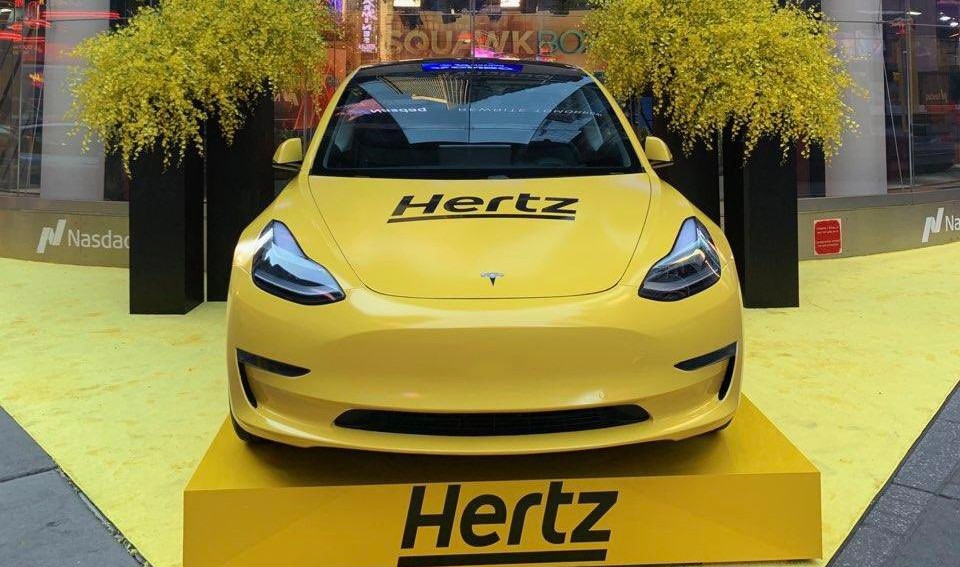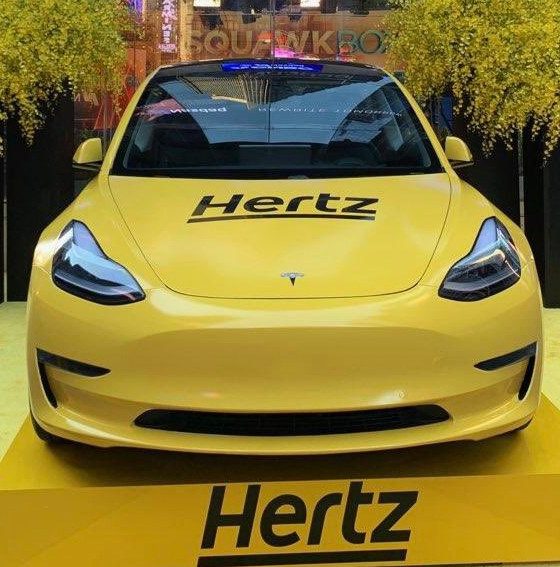

Investor's Corner
Hertz doubles down on electrification following record earnings, stock surges 7%
Hertz (NASDAQ: HTZ) has announced that it will continue rapidly electrifying its fleet of rental vehicles following its record earnings report for 2022.
Hertz is a clear leader in electrification in the car rental market, and buyers have responded accordingly. Hertz reported record earnings for 2022, despite numerous setbacks in the economy. Moving forward, Hertz made it clear that it will continue to double down on the things that made it so successful last year; electrification, expanded distribution, and excellence in execution.
According to Hertz’s earnings report from this morning, the company earned a record $8.7 billion in revenue during 2022, $2 billion of which was earned in Q4 of the year. On top of that, Hertz had a record GAAP net income of $2.1 billion in 2022, reaching $3.36 per diluted share. Key financial contributors include a heightened EBITDA margin of 27% and increased fleet utilization globally compared to 2021.
Hertz did not have EV-specific sales or rental data in its earnings deck.
Following this revenue boom, Hertz stock jumped by over 7 percent, encouraged by the continued growth of the travel industry post-COVID.
But what differentiator had made the company so profitable? Hertz CEO Stephen Scherr points to electrification:
“Our team delivered on renewed demand for travel, which is continuing. In 2023, we will build on our progress to grow our business across the Hertz, Dollar, and Thrifty brands. We look to our investments in electrification and technology to yield increasing operating leverage and improved returns and an even better product to our customers around the world.”
Hertz made shockwaves in the rental industry when it announced that it was purchasing 100,000 Tesla Model 3s at the end of 2021, and since then, the company has only increased its investment. Following the massive Tesla deal, Hertz has ordered 175,000 EVs from General Motors and 65,000 from Polestar. Furthermore, the company has partnered with BP Pulse to begin installing charging infrastructure at each rental location.
While Hertz’s earnings presentation stated that it would grow its “EV fleet across multiple OEMs,” the rental agency did not specify what other automakers it may work with to purchase more EVs.
On top of these investments, Hertz has also been unique in its efforts to make their new massive fleet of EVs as profitable as possible. Perhaps the best example is the rental agency’s partnership with Uber, allowing Uber drivers to rent an EV for a discounted weekly fee.
This is to say nothing of the inherent benefits Hertz’s EV fleet has brought the brand. Just last year, Hertz executives excitedly announced that interest in EV rentals had shot through the roof, all while reducing operating costs for the company.
Hertz is headed in the right direction financially, largely thanks to its massive investments in electrification over the past year and a half. Hopefully, the company will continue to grow its electrification focus, resulting in continued positive financial indicators and a more sustainable mobility offering overall.
William is not a Hertz shareholder, nor does he own shares in index/mutual funds including the Hertz corporation.
What do you think of the article? Do you have any comments, questions, or concerns? Shoot me an email at william@teslarati.com. You can also reach me on Twitter @WilliamWritin. If you have news tips, email us at tips@teslarati.com!

Investor's Corner
Tesla stock closes at all-time high on heels of Robotaxi progress

Tesla stock (NASDAQ: TSLA) closed at an all-time high on Tuesday, jumping over 3 percent during the day and finishing at $489.88.
The price beats the previous record close, which was $479.86.
Shares have had a crazy year, dipping more than 40 percent from the start of the year. The stock then started to recover once again around late April, when its price started to climb back up from the low $200 level.
This week, Tesla started to climb toward its highest levels ever, as it was revealed on Sunday that the company was testing driverless Robotaxis in Austin. The spike in value pushed the company’s valuation to $1.63 trillion.
Tesla Robotaxi goes driverless as Musk confirms Safety Monitor removal testing
It is the seventh-most valuable company on the market currently, trailing Nvidia, Apple, Alphabet (Google), Microsoft, Amazon, and Meta.
Shares closed up $14.57 today, up over 3 percent.
The stock has gone through a lot this year, as previously mentioned. Shares tumbled in Q1 due to CEO Elon Musk’s involvement with the Department of Government Efficiency (DOGE), which pulled his attention away from his companies and left a major overhang on their valuations.
However, things started to rebound halfway through the year, and as the government started to phase out the $7,500 tax credit, demand spiked as consumers tried to take advantage of it.
Q3 deliveries were the highest in company history, and Tesla responded to the loss of the tax credit with the launch of the Model 3 and Model Y Standard.
Additionally, analysts have announced high expectations this week for the company on Wall Street as Robotaxi continues to be the focus. With autonomy within Tesla’s sights, things are moving in the direction of Robotaxi being a major catalyst for growth on the Street in the coming year.
Elon Musk
Tesla needs to come through on this one Robotaxi metric, analyst says
“We think the key focus from here will be how fast Tesla can scale driverless operations (including if Tesla’s approach to software/hardware allows it to scale significantly faster than competitors, as the company has argued), and on profitability.”

Tesla needs to come through on this one Robotaxi metric, Mark Delaney of Goldman Sachs says.
Tesla is in the process of rolling out its Robotaxi platform to areas outside of Austin and the California Bay Area. It has plans to launch in five additional cities, including Houston, Dallas, Miami, Las Vegas, and Phoenix.
However, the company’s expansion is not what the focus needs to be, according to Delaney. It’s the speed of deployment.
The analyst said:
“We think the key focus from here will be how fast Tesla can scale driverless operations (including if Tesla’s approach to software/hardware allows it to scale significantly faster than competitors, as the company has argued), and on profitability.”
Profitability will come as the Robotaxi fleet expands. Making that money will be dependent on when Tesla can initiate rides in more areas, giving more customers access to the program.
There are some additional things that the company needs to make happen ahead of the major Robotaxi expansion, one of those things is launching driverless rides in Austin, the first city in which it launched the program.
This week, Tesla started testing driverless Robotaxi rides in Austin, as two different Model Y units were spotted with no occupants, a huge step in the company’s plans for the ride-sharing platform.
Tesla Robotaxi goes driverless as Musk confirms Safety Monitor removal testing
CEO Elon Musk has been hoping to remove Safety Monitors from Robotaxis in Austin for several months, first mentioning the plan to have them out by the end of 2025 in September. He confirmed on Sunday that Tesla had officially removed vehicle occupants and started testing truly unsupervised rides.
Although Safety Monitors in Austin have been sitting in the passenger’s seat, they have still had the ability to override things in case of an emergency. After all, the ultimate goal was safety and avoiding any accidents or injuries.
Goldman Sachs reiterated its ‘Neutral’ rating and its $400 price target. Delaney said, “Tesla is making progress with its autonomous technology,” and recent developments make it evident that this is true.
Investor's Corner
Tesla gets bold Robotaxi prediction from Wall Street firm
Last week, Andrew Percoco took over Tesla analysis for Morgan Stanley from Adam Jonas, who covered the stock for years. Percoco seems to be less optimistic and bullish on Tesla shares, while still being fair and balanced in his analysis.

Tesla (NASDAQ: TSLA) received a bold Robotaxi prediction from Morgan Stanley, which anticipates a dramatic increase in the size of the company’s autonomous ride-hailing suite in the coming years.
Last week, Andrew Percoco took over Tesla analysis for Morgan Stanley from Adam Jonas, who covered the stock for years. Percoco seems to be less optimistic and bullish on Tesla shares, while still being fair and balanced in his analysis.
Percoco dug into the Robotaxi fleet and its expansion in the coming years in his latest note, released on Tuesday. The firm expects Tesla to increase the Robotaxi fleet size to 1,000 vehicles in 2026. However, that’s small-scale compared to what they expect from Tesla in a decade.
Tesla expands Robotaxi app access once again, this time on a global scale
By 2035, Morgan Stanley believes there will be one million Robotaxis on the road across multiple cities, a major jump and a considerable fleet size. We assume this means the fleet of vehicles Tesla will operate internally, and not including passenger-owned vehicles that could be added through software updates.
He also listed three specific catalysts that investors should pay attention to, as these will represent the company being on track to achieve its Robotaxi dreams:
- Opening Robotaxi to the public without a Safety Monitor. Timing is unclear, but it appears that Tesla is getting closer by the day.
- Improvement in safety metrics without the Safety Monitor. Tesla’s ability to improve its safety metrics as it scales miles driven without the Safety Monitor is imperative as it looks to scale in new states and cities in 2026.
- Cybercab start of production, targeted for April 2026. Tesla’s Cybercab is a purpose-built vehicle (no steering wheel or pedals, only two seats) that is expected to be produced through its state-of-the-art unboxed manufacturing process, offering further cost reductions and thus accelerating adoption over time.
Robotaxi stands to be one of Tesla’s most significant revenue contributors, especially as the company plans to continue expanding its ride-hailing service across the world in the coming years.
Its current deployment strategy is controlled and conservative to avoid any drastic and potentially program-ruining incidents.
So far, the program, which is active in Austin and the California Bay Area, has been widely successful.








